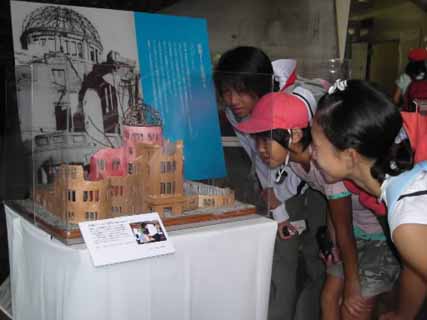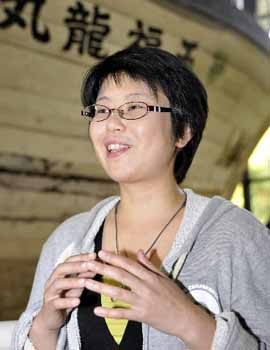Exhibition on A-bomb Dome and Daigo Fukuryu Maru now being held
Oct. 16, 2008
by Koji Kitamura, Staff Writer
An exhibition entitled “Peace Heritage Preserved by Citizens: The A-bomb Dome and the Daigo Fukuryu Maru” is being held at the Daigo Fukuryu Maru Exhibition Hall in Tokyo through December 21.
Displays on the A-bomb Dome include photo panels which depict fundraising campaigns for preservation efforts, iron framing from the building that was removed due to repair work, and a small model of the dome made by a high school student in Saitama Prefecture. Exhibits on the Daigo Fukuryu Maru (“The Lucky Dragon No. 5”) feature such items as the records of preservation activities undertaken by citizens after the fishing boat was retired from use.
The preservation campaign for the Daigo Fukuryu Maru began 40 years ago when a letter from a male reader, who was inspired by the preservation of the A-bomb Dome and called for the same effort for the ship, appeared in a newspaper.
Shota Wakasugi, 12, a sixth grader at Higashi Mashizu Elementary School in the city of Yaizu, visited the exhibition as part of a school trip. Yaizu is where Aikichi Kuboyama, the boat’s chief radio operator who died of radiation exposure, was born. Wakasugi commented, “I see that people have cared well for both the A-bomb Dome and the Daigo Fukuryu Maru.”
(Originally published on October 9, 2008)
Mari Ichida, exhibition organizer
by Koji Kitamura, Staff Writer
Mari Ichida, 41, is a curator at the Daigo Fukuryu Maru Exhibition Hall in Tokyo. The main organizer for “Peace Heritage Preserved by Citizens: The A-bomb Dome and the Daigo Fukuryu Maru,” Ms. Ichida hopes the exhibition will draw attention to the fact that the Daigo Fukuryu Maru and the A-bomb Dome are not only symbols of nuclear age tragedy, they have both been protected through the efforts of citizens.
The Daigo Fukuryu Maru, a tuna fishing boat, was exposed to radiation during a nuclear test by the United States in 1954. After being used as a training ship by a university, the vessel was retired and left abandoned in Yumenoshima, Tokyo. When a local newspaper printed a letter to the editor declaring that the boat “should be preserved like the A-bomb Dome,” the preservation campaign was born.
A number of volunteers became involved in such preservation work as scooping out water trapped inside the boat and repainting it. Finally, in 1976, the Daigo Fukuryu Maru Exhibition Hall opened. Ms. Ichida takes the protection of the ship seriously, stating, “This boat is like an important baton that must be passed on to the next generation.”
At the same time, her ambitions are still down-to-earth. She also organizes art exhibitions and concerts at the exhibition hall and visitors range from people who simply drop in while strolling past to others who sit to muse over personal memories. Smiling, she said, “I hope this hall is a place where anyone can stop in for a chance to reflect. And I hope people find that I’m someone they can talk to easily.”
Ms. Ichida majored in history at Nihon University, but, she remarked, “I knew so little about the A-bomb Dome or the Daigo Fukuryu Maru back then.” Later, an acquaintance invited her to help out at the Japan Peace Museum, an organization which collects and sorts materials mainly related to nuclear tragedy. Through this work, she learned about the Daigo Fukuryu Maru and became involved in the management of the exhibition hall six years ago.
Currently, Ms. Ichida works for the exhibition hall three days a week and the Japan Peace Museum four days a week, without a day off. “I enjoy both jobs,” she said. “The two jobs complement each other well and offer variety in my work routine.”
(Originally published on October 12, 2008)
Related articles The hidden truth of the Bikini Incident (March 7, 2008)
Fifty-four years after the Bikini Incident: An interview with Matashichi Oishi, former crewman on the Daigo Fukuryu Maru (Feb. 28, 2008)
An exhibition entitled “Peace Heritage Preserved by Citizens: The A-bomb Dome and the Daigo Fukuryu Maru” is being held at the Daigo Fukuryu Maru Exhibition Hall in Tokyo through December 21.
Displays on the A-bomb Dome include photo panels which depict fundraising campaigns for preservation efforts, iron framing from the building that was removed due to repair work, and a small model of the dome made by a high school student in Saitama Prefecture. Exhibits on the Daigo Fukuryu Maru (“The Lucky Dragon No. 5”) feature such items as the records of preservation activities undertaken by citizens after the fishing boat was retired from use.
The preservation campaign for the Daigo Fukuryu Maru began 40 years ago when a letter from a male reader, who was inspired by the preservation of the A-bomb Dome and called for the same effort for the ship, appeared in a newspaper.
Shota Wakasugi, 12, a sixth grader at Higashi Mashizu Elementary School in the city of Yaizu, visited the exhibition as part of a school trip. Yaizu is where Aikichi Kuboyama, the boat’s chief radio operator who died of radiation exposure, was born. Wakasugi commented, “I see that people have cared well for both the A-bomb Dome and the Daigo Fukuryu Maru.”
(Originally published on October 9, 2008)
Mari Ichida, exhibition organizer
by Koji Kitamura, Staff Writer
Mari Ichida, 41, is a curator at the Daigo Fukuryu Maru Exhibition Hall in Tokyo. The main organizer for “Peace Heritage Preserved by Citizens: The A-bomb Dome and the Daigo Fukuryu Maru,” Ms. Ichida hopes the exhibition will draw attention to the fact that the Daigo Fukuryu Maru and the A-bomb Dome are not only symbols of nuclear age tragedy, they have both been protected through the efforts of citizens.
The Daigo Fukuryu Maru, a tuna fishing boat, was exposed to radiation during a nuclear test by the United States in 1954. After being used as a training ship by a university, the vessel was retired and left abandoned in Yumenoshima, Tokyo. When a local newspaper printed a letter to the editor declaring that the boat “should be preserved like the A-bomb Dome,” the preservation campaign was born.
A number of volunteers became involved in such preservation work as scooping out water trapped inside the boat and repainting it. Finally, in 1976, the Daigo Fukuryu Maru Exhibition Hall opened. Ms. Ichida takes the protection of the ship seriously, stating, “This boat is like an important baton that must be passed on to the next generation.”
At the same time, her ambitions are still down-to-earth. She also organizes art exhibitions and concerts at the exhibition hall and visitors range from people who simply drop in while strolling past to others who sit to muse over personal memories. Smiling, she said, “I hope this hall is a place where anyone can stop in for a chance to reflect. And I hope people find that I’m someone they can talk to easily.”
Ms. Ichida majored in history at Nihon University, but, she remarked, “I knew so little about the A-bomb Dome or the Daigo Fukuryu Maru back then.” Later, an acquaintance invited her to help out at the Japan Peace Museum, an organization which collects and sorts materials mainly related to nuclear tragedy. Through this work, she learned about the Daigo Fukuryu Maru and became involved in the management of the exhibition hall six years ago.
Currently, Ms. Ichida works for the exhibition hall three days a week and the Japan Peace Museum four days a week, without a day off. “I enjoy both jobs,” she said. “The two jobs complement each other well and offer variety in my work routine.”
(Originally published on October 12, 2008)
Related articles The hidden truth of the Bikini Incident (March 7, 2008)
Fifty-four years after the Bikini Incident: An interview with Matashichi Oishi, former crewman on the Daigo Fukuryu Maru (Feb. 28, 2008)









